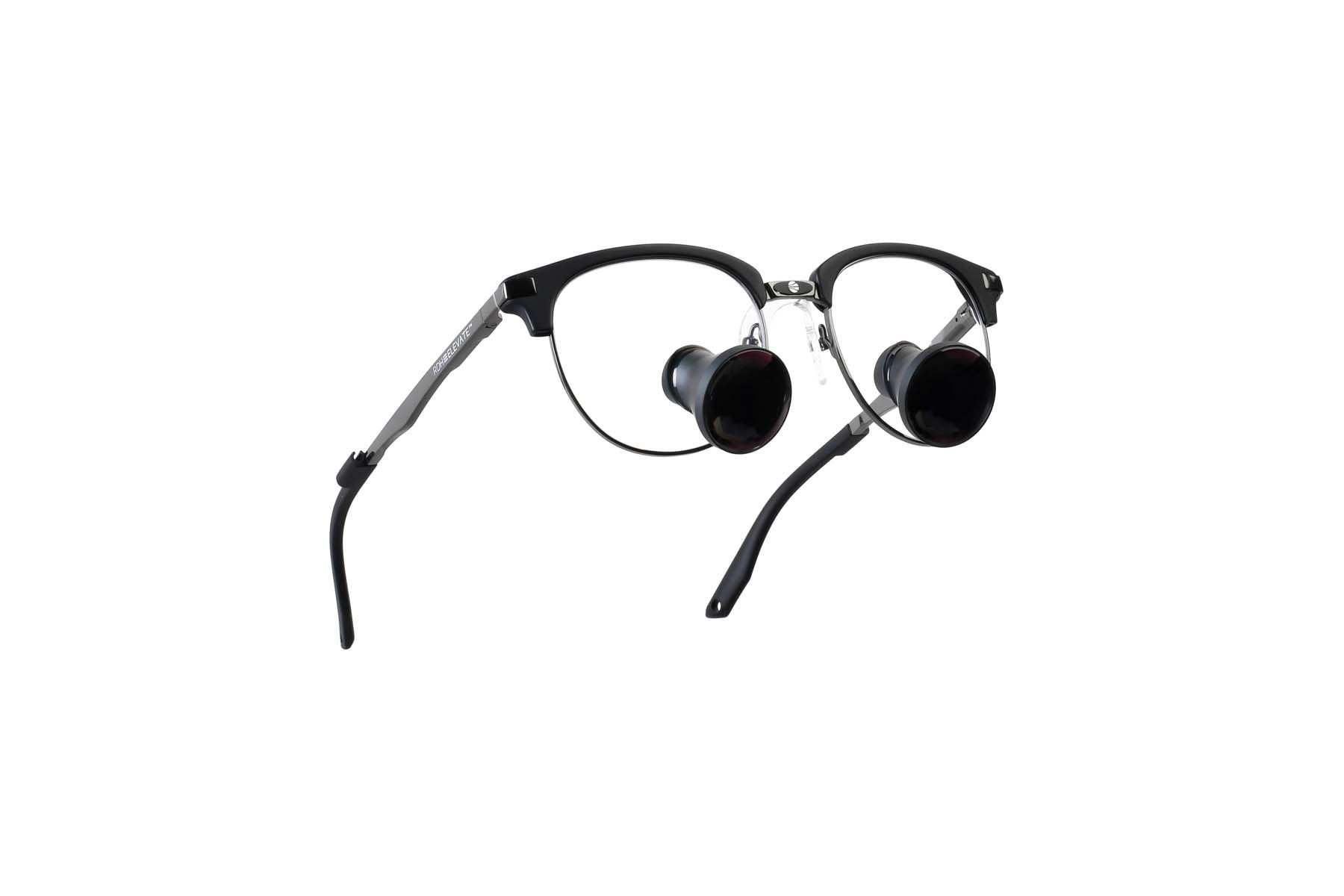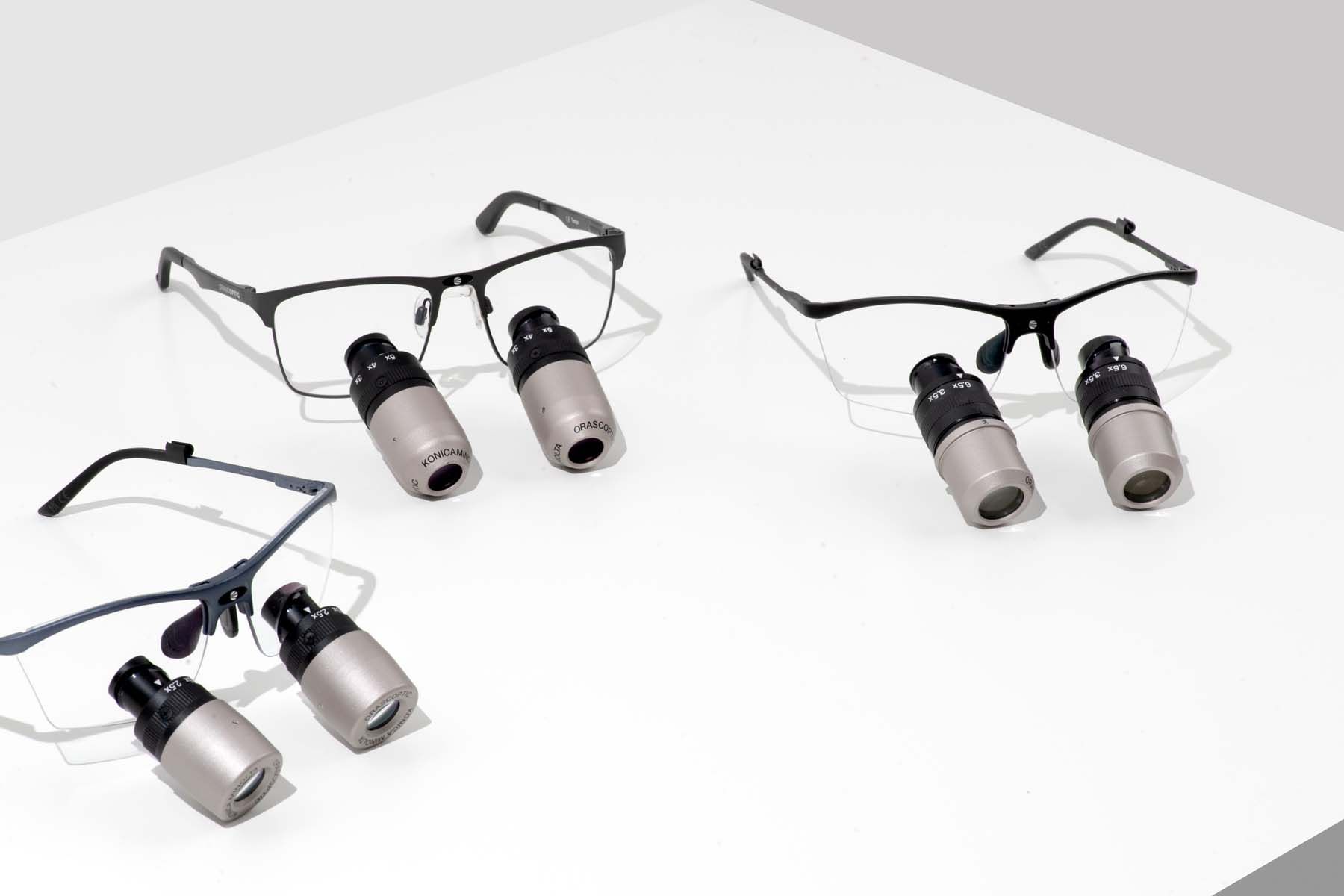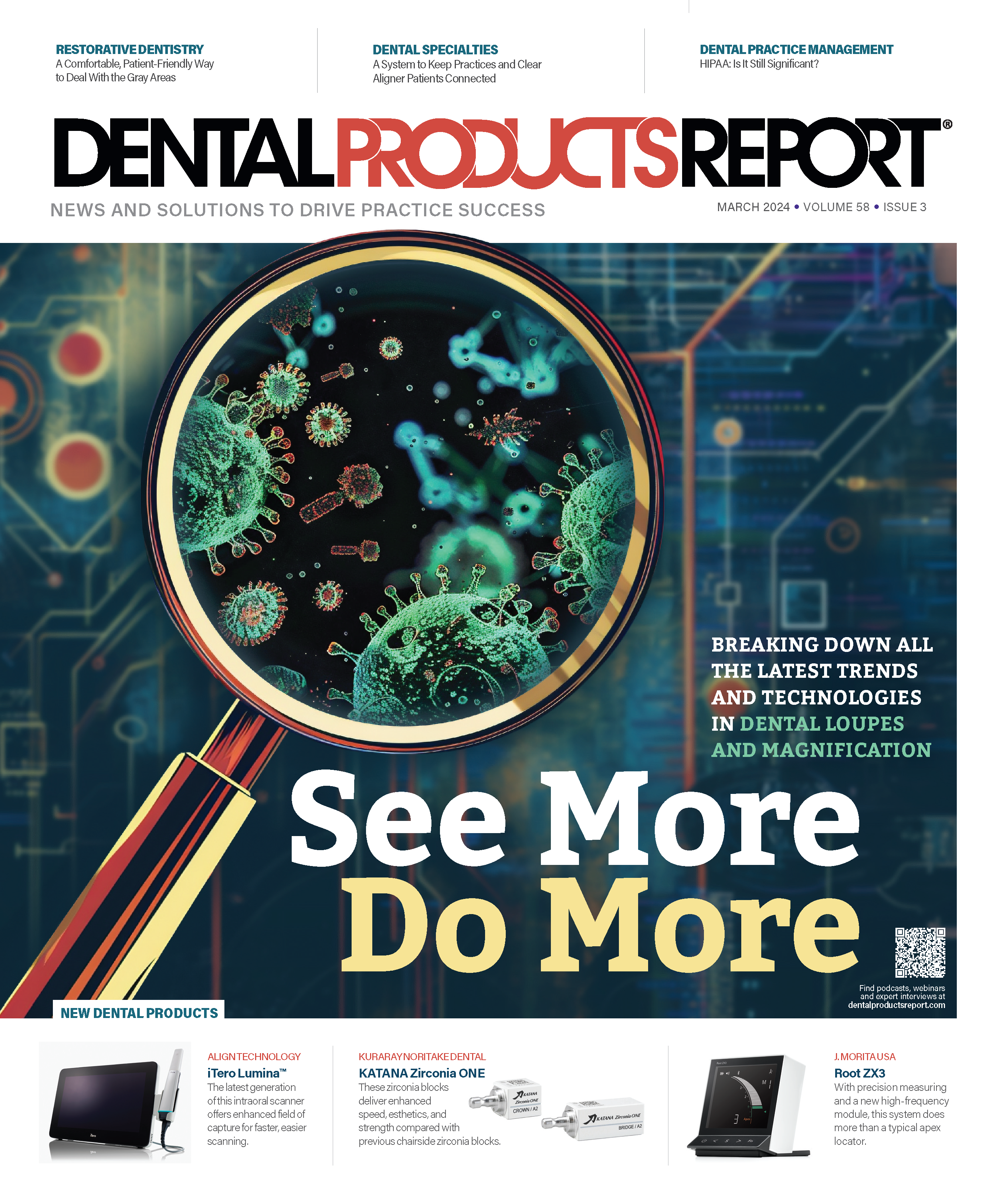See More Do More
Breaking down all the latest trends and technologies in dental loupes and magnification.
Image by Kristen Morabito / MJH Life Sciences using AI

For the longest time, we’ve known that using loupes is critical when it comes to seeing inside the mouths of patients. Magnification is essential, and using loupes—and even surgical microscopes—has allowed dentists and hygienists to deliver better care. After all, it’s hard to fix what you can’t see.
Dental loupes and magnification have changed for the better over the years, with lighter, more comfortable designs and a variety of magnifications designed to aid clinicians. Much has been written about the importance of ergonomics in the dental operatory, with seating, lighting, and cabinet and delivery system locations all revamped over the years to help staff with everyday work that can be physically and mentally stressful.
After decades of clinicians working through back and neck pain caused by the often awkward movements and difficult posture positions required to examine a patient’s mouth, a much-needed focus was given in recent years to protecting dentists and hygienists, who are more susceptible to musculoskeletal injuries and disorders. Dental professionals frequently suffer from back and neck pain caused by the awkward, forward-hunching posture that is necessary to examine a patient’s mouth.
Orascoptic’s RDH Line: Designed to work in comfort and prolong careers.

“Magnification provides an ergonomic solution that can reduce musculoskeletal discomfort and improve patient outcomes,” says Erica Born, marketing manager, consumer strategy, at Orascoptic. “Loupes can help dentists and hygienists reduce back and neck discomfort, see the mouth with more clarity, and improve efficiency.”
Katrina Klein, RDH, CEAS, CPT, is a certified ergonomics assessment specialist and a certified personal trainer in addition to a hygienist, and she’s well aware of the importance of using proper magnification to reduce pain while improving your work.
“Studies have shown that magnification is the number one impactful piece of equipment for reducing workplace injury. Stated more simply, they significantly help reduce our pain from practicing,” says Klein. “Wearing loupes benefits clinicians by promoting a neutral body posture. Magnification keeps the upper body at a safe working distance.”
What’s New?
While manufacturers have been providing magnification solutions for dental practitioners for decades, a newer trend has brought about a newer category of loupes—ergo loupes. While earlier versions were indeed designed to combat back and neck pain and eyestrain, today’s loupes help clinicians improve their posture and mitigate neck discomfort.
Featured on the cover of Dental Products Report in April 2023, Orascoptic’s High Definition Ergo loupes tout a 3.5x magnification that allows users to reduce neck tilt while maintaining a clear view of the treatment area. The loupes are mounted through the lens with a field width of 8.5 cm and a field depth of 8 cm.
EyeZoom Family: These loupes from Orascoptic are the only 3-in-1 variable magnification loupes. Users can switch seamlessly among magnification levels 3x, 4x, and 5x.

“Ergo loupes are a great new option in clinicians’ ergonomic toolbox. Using ergo loupes allows the user to sit up straight, further reducing back and neck discomfort,” adds Born, who also notes the importance of choosing the best loupes for each individual team member. “Loupes are an important tool for clinicians as they function as an extension of themselves—having loupes that are custom-made to each user is essential for proper function, which in turn improves patient outcomes.”
The InfinityVUE Loupes from Designs for Vision, Inc, are designed to provide a straightforward approach to ergonomics and are available in 3.0x, 3.5x, and 4.5x magnification. Infinity VUE Loupes with Vision Up Ergonomics are said to keep a practitioner’s chin up, neck straight, and eyes forward while viewing the oral cavity. By changing the positioning of the internal prisms, these loupes allow you to see intraorally without having to bend your neck.
Irene Iancu, BSc, RRDH, CTDP, OM, gave a presentation on the Infinity VUE Loupes at the Greater New York Dental Meeting last fall and explained that if you wear standard telescopes, you know that although your magnification is great and your posture may be great, you may also still be suffering from head and neck pain because of the angle of declination and from bringing your chin down and forward.
Designs For Vision: Designed to provide a straightforward approach to ergonomics, the Infinity VUE Loupes are available in 3.0x, 3.5x, and a new 4.5x magnification.

What these new ergonomic loupes do is bring your chin up and your posture back because you are looking straight down at the patient, instead of having to bring your chin down in the line of vision as you do with traditional loupes. “It’s kind of like using a microscope, but the microscope is attached to your loupes,” says Iancu, a restorative dental hygienist from Toronto, Canada.
Mounted on a Steam frame and with the side shields attached, the VUE Loupes weigh 3.2 oz. They arrive in a plastic case with a secure fastener that keeps the loupes protected.
Enova Illumination provides loupes and surgical microscopes to the dental industry. The Minneapolis, Minnesota, company’s Vizix® Ergo Elite Loupes are the company’s latest product with a big emphasis on protecting the health of oral caregivers.
Available in 3.5x, 4.5x, and 5.5x magnifications, they are described as a lightweight, ergonomic, angled prismatic loupes that provide unparalleled visibility through the lens. They are designed to support natural posture and therefore help prevent pain caused by the awkward, unnatural movements often associated with using traditional loupes. The Vizix Ergo Elite Loupes can be paired with any frame in the company’s Airon™ series.
“When using prismatic [ergo] loupes, the spine, head, and neck are in neutral,” adds Klein, who uses the 3.0 ErgoPrism Airs by LumaDent. “The majority of our pain comes from putting our heads down into flexion so to reduce or eliminate the primary cause for pain is a huge benefit.”
Scott Green, executive vice president for Enova Illumination, is proud that his company has played a role in improving the way clinicians see and practice dentistry and in how improved magnification helps clinicians stay healthy and extend their careers.
“When my dad started practicing over 50 years ago, dentistry was done without any magnification, including loupes and microscopes,” Green says. “It was not uncommon for a dentist to work as close as 6 to 8 inches from the patient’s face. You could always tell a dentist because their shoulders were rounded. With that being said, the biggest advantage that we’ve seen is the ergonomic body positioning that has improved over the years. We’ve gone from traditional loupes to ergo deflection loupes to now microscopes.”
Loupes and microscopes have enabled dentists and hygienists to visualize the oral cavity in much greater detail at a much farther distance. This allows them to identify pathology, decay, and anatomy that would otherwise be very difficult to see with the naked eye, Green explains. Using these tools leads to more accurate diagnoses and improved treatment precision and success rates, all while clinicians are in a more upright position that protects them from back and neck fatigue and pain.
Surgical Microscopes: Magnification using a microscope gives dental professionals the opportunity to offer a higher standard of care. Enova is the exclusive US distributor of Zumax® microscopes. While most endodontists use microscopes to assist in their procedures, general practitioners can take advantage of the technology to help them with a variety of everyday restorative procedures.

“Using dental loupes enhances ergonomic positioning and postural alignment, minimizing back and neck strain and discomfort. Loupes help magnify tiny details, revealing hidden cavities and cracks and pathology for improved accuracy. Also, loupes can help the user become more precise, resulting in better proficiency and happier/satisfied patients,” Green adds.
Surgical Microscopes
It is quite common for specialists to use a surgical microscope for endodontics and other surgeries, but general practitioners should also consider using the technology for many—if not all—of their restorative cases.
Glenn DeWeirdt, DDS, has been using microscopes for 2 decades, and he uses them on a regular basis.
“I’ve been using dental operating microscopes in my practice since the early 2000s, which makes me one of [their] very early adopters,” says Dr DeWeirdt, a dentist in Woodridge, Illinois. “I use my microscopes for everything from oral surgery and endodontics, of course, which is [their] primary use. We’ve been using surgical microscopes since they first came into widespread mainstream use in the dental profession. I use them to perform all my crown and bridge [work]. I literally do every procedure using the dental operating microscope.”
Because the microscopes allow him to see such detail, the technology enables Dr DeWeirdt to perform better treatments for
his patients.
A Fine Fit: Enova’s Vizix loupes are meticulously crafted for a custom fit to best suit the clinician.

“Absolutely. There’s no question about it,” he says. “What general dentists in particular don’t really realize is that when they embrace high magnification using the dental operating microscope, not only does it improve your quality of care, but it makes you more efficient as well. Because with the ergonomic benefits, the fact [is] that your posture is much better…. I often tell people, I’m 66 years old and I don’t have neck problems, back problems, or eyestrain problems. That [pain] causes many dentists to retire before they’d like to. Sure, a lot of that is just good genes, of course, but much of it is having used dental operating microscopes in my practice for well over 20 years.”
Dr DeWeirdt, an active lecturer on the topic of magnification and a frequent speaker at the Chicago Dental Society Midwinter Meeting and at dental study clubs in the area, uses surgical microscopes and loupes from ZEISS and is a consultant for the international leader in advanced optics. There are 5 ZEISS microscopes in his Hobson Dental Associates practice in Woodridge, a western suburb of Chicago.
While many clinicians currently use microscopes for endodontic procedures, he stresses how beneficial they are for him when performing all dental treatments. Loupes, such as the EyeMag® medical loupes from ZEISS, offer premium optical performance for users in dentistry, neurosurgery, spine surgery, and more. Typical dental loupes range from 2.5x to 5.0x magnification, while surgical microscopes are in a whole different range.
“I guess I could distill that down into what one of my clinical instructors told me, which was, ‘What you don’t see, you’ll never know,’”
Dr DeWeirdt says. “With typical loupes, for example, high-power loupes, you’re usually talking around 2.5x or 5x. I’m doing many of my dental procedures, operative endodontics, and even oral surgery at 18x to 22x power magnification.
“So, you’re seeing everything. There are no secrets.”
While Dr DeWeirdt’s practice uses traditional loupes, not the ergo loupes that have gained in popularity, he knows many clinicians who like the newer versions because of the reduction in pain. But he also believes there is a trade-off in terms of visibility when comparing ergo loupes with the traditional models.
“I teach, and many of the students have the ergo loupes, and they’re great,” he explains. “In my personal opinion, from what I’ve observed and what I’ve experienced, the ergo loupes tend to solve a significant ergonometric problem at the expense of a visibility problem.”
With ergo loupes, the field of view tends to be a little smaller. Also, the focal length of those loupes must be very accurately measured, and this can be difficult because of all the variations including the different heights of the clinicians.
“So, I would say that ergo loupes are a wonderful, wonderful tool when they are set up properly. But my focus is on microscopes, where you don’t have any of those issues. Once a clinician can move past the small initial adaptation issues, they can go to town and be more accurate, more efficient,” he says. “To me it’s a no-brainer, so I can do an incredibly accurate crown preparation in 10 minutes. And patients appreciate it because they’re not [lying] back for 30 to 45 minutes. It’s absolutely a tool that I have embraced. And in my practice, and for me, it is an essential tool.”
Enova’s Green agrees, stating that microscopes aid in a number of number procedures.
Comfort Is Key: The Dragonfly seamlessly combines Orascoptic’s leading optics and award-winning headlight into a single, lightweight product.

“Dental microscopes are critical for procedures like root canals (endodontics), examining cracks and tooth trauma, placing posts, implants, intricate preparations for crowns/bridges/inlays, identifying/refining margins for impression taking, and periodontal surgery,” Green says. “They provide high magnification and coaxial illumination for very minute and delicate dental procedures. Also, they are fantastic at educating patients and documenting procedures when they have an integrated digital camera.”
A Look at the Future
Some companies have developed 3D vision goggles, and there are products currently in development designed to allow clinicians to wear a headset while delivering a 3D view and magnification that assists with treatments.
Dr DeWeirdt says some of these concepts have been around for years, and he sees promise in 3D microscopes in the future.
“It’s not a new concept, actually,” he says. “Back about 10 to 12 years ago we had a headset type of thing. Now, I think what may be in the works is something where it’s combined with a virtual reality or 3D type of system. And the 3D microscope systems are, I believe, very promising.”
Dr DeWeirdt had the opportunity to preview a 3D microscope system in his practice about 5 years ago. While it didn’t work well for him in part due to some minor vertigo issues, he realizes that it may be a good option for some clinicians, especially new users not trained on traditional microscopes and loupes for many years.
“From my point of view, I want to communicate to my fellow dentists that high magnification has just incredible value in terms of patient care,” he says. “How that magnification is utilized, whether it’s 3D, whether it’s video, virtual reality, or traditional microscope, really doesn’t matter that much. Having said that, the traditional microscope, binocular microscope, is really, in the end, the easiest and the cheapest way to achieve high magnification.”
The bottom line, as clinicians have come to know, is that you can do more for your patients when you can see more.

ACTIVA BioACTIVE Bulk Flow Marks Pulpdent’s First Major Product Release in 4 Years
December 12th 2024Next-generation bulk-fill dental restorative raises the standard of care for bulk-fill procedures by providing natural remineralization support, while also overcoming current bulk-fill limitations.